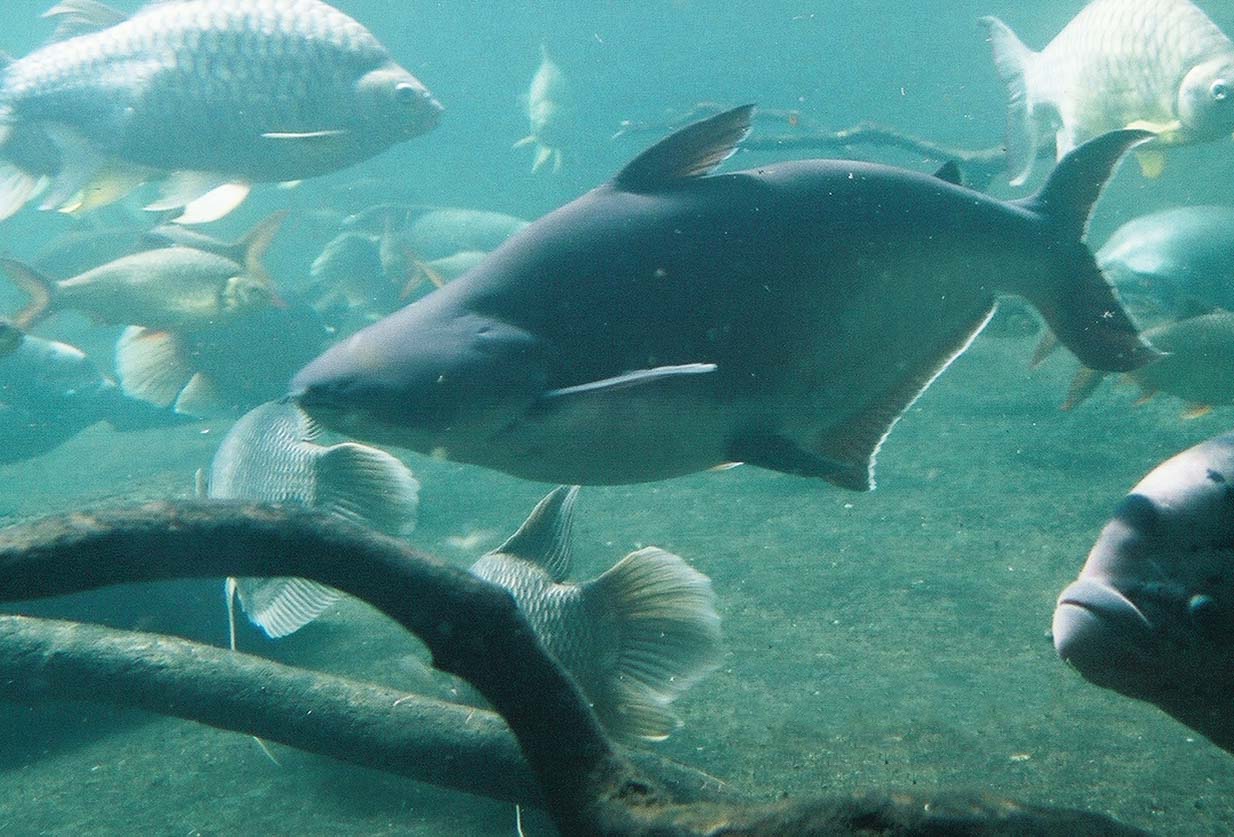- Iridescent shark
Taxobox
name = Iridescent shark

image_width = 240px
status = NT
status_system = IUCN3.1
regnum =Animal ia
phylum = Chordata
classis =Actinopterygii
ordo =Siluriformes
familia =Pangasiidae
genus = "Pangasius "
species = "P. hypophthalmus"
binomial = "Pangasius hypophthalmus"
binomial_authority = (Sauvage ,1878 )Despite its name, iridescent shark, "Pangasius hypophthalmus" is not ashark , but acatfish . This fish is also known as Siamese shark or sutchi catfish in theaquarium hobby or as tra, swai, or striped catfish in the food fish market, and occasionally incorrectly as basa and panga (though these names should be rather used for "Pangasius bocourti " and "Pterogymnus laniarius ", respectively). The species is found inSoutheast Asia in theMekong basin as well as theChao Phraya river, and is heavily cultivated for food there. It has also been introduced into other river basins as a food source and is common in the fishkeeping hobby. It is named for its glow oriridescence exhibited in juveniles.Their
omnivorous diet consists ofcrustacean s, other fish, and plant matter.Distribution and habitat
Iridescent sharks originate from the large
river sChao Phraya andMekong inAsia , though they have been introduced into other rivers for aquaculture. They are afreshwater fish that natively live in atropical climate and prefer water with a 6.5 - 7.5pH , a water hardness of 2.0 to 29.0dGH , and a temperature range of 72 to 79 ° F (22 to 26 ° C).FishBase_species_alt|ID=14154|taxon=Pangasius hypophthalmus|year=2007|month=March] They prefer large bodies of water similar to the deep waters of their native Mekong river basin.The iridescent shark is a migratory fish that moves upstream to spawn during the flood season while the waters are high and returns downstream to seek rearing habitats when the river water levels recede. Upstream migration in this species appears to be triggered by receding waters. At the end of the flood season, the fish migrate back downstream away from flooded waters. The dates of the migrations vary depending on the river system. In the Mekong river basin, they migrate upstream in May to July and return downstream during September through December. South of the
Khone Falls , upstream migration occurs in October to February, with its peak in November to December.Physical Characteristics
The fins are dark grey or black. Juveniles have a black stripe along the lateral line and a second black stripe below the lateral line; they have a shiny, iridescent color that gives these fish their name. However, large adults are uniformly grey and lack the striping. Adults reach up to 130 cm (4 ft) in length and can weigh up to a maximum of 44.0 kg (97 lb).
Food source
"P. hypophthalmus" is an important food fish and is farmed extensively in many parts of the world. It is one of the most important
aquaculture species in Thailand and Vietnam. Along with other farm-raisedshark catfish es, it has caused much debate within the U.S., with legislation passed recently to prevent its imports from cutting into American farmed catfish sales. Prohibited to be labelled as "catfish" in the U.S., "P. hypophthalmus" is now labelled as "swai" (its Thai name), "sutchi catfish", or "striped catfish". In Vietnam, this fish is known as "tra".cite web| url = http://www.seafoodbusiness.com/buyguide/issue_basa.htm | publisher = Seafood Business | title = Buyer's Guide - Basa Catfish | date = 2001-11 | accessdate = 2007-03-31]This fish is sometimes sold as the superior "basa". Compared to the basa, this fish is thought to be inferior, as its meat is coarser and comes in thinner. Despite this, swai is still common as it is much cheaper to maintain, easier to breed, and is also a faster-growing species. It is said that 90% of fish sold as basa is actually swai.
In the aquarium
Juvenile iridescent sharks are often sold as pets for home
aquarium s. However they are not easy fish to keep and are not recommended for most home aquariums. Iridescent sharks are schooling fish that prefer to be kept in groups of 5 or more. Accustomed to living in rivers, they are very active fish that require a lot of space. If stressed, their first instinct is to flee, and such a blind dash can result in injuries, especially in an aquarium environment. These flights may be terminated by the fish sinking to the bottom, where it may lie on its side or back until it recovers.cite book | title = Exotic Tropical Fishes | last = Axelrod | first = Herbert, R. | publisher = T.F.H. Publications. | year = 1996 | id = ISBN 0-87666-543-1] Despite their excellent eyesight they may swim into the glass of a tank and hurt themselves.Many fish owners are unaware of the enormous size that an iridescent shark can reach. If given enough room and fed adequately, an individual of this species can reach 3 feet in length. In most home aquariums, the amount of space an iridescent shark has severely stunts its growth. Therefore, most iridescent sharks kept in home aquaria grow to only six to twelve inches in length and die prematurely from organ failure. As a rule of thumb, an iridescent shark requires a minimum tank size of 3 m (10 feet) to grow to a healthy size. Schools require even larger tanks. [http://www.aqualandpetsplus.com/Catfish,%20Pangassius.htm Aqualand Pets] ]
There is also an albino morph available.
ee also
*
List of freshwater aquarium fish species References
External links
*
* [http://www.planetcatfish.com/catelog/pangasii/pangasiu/172_f.php Pictures]
Wikimedia Foundation. 2010.
